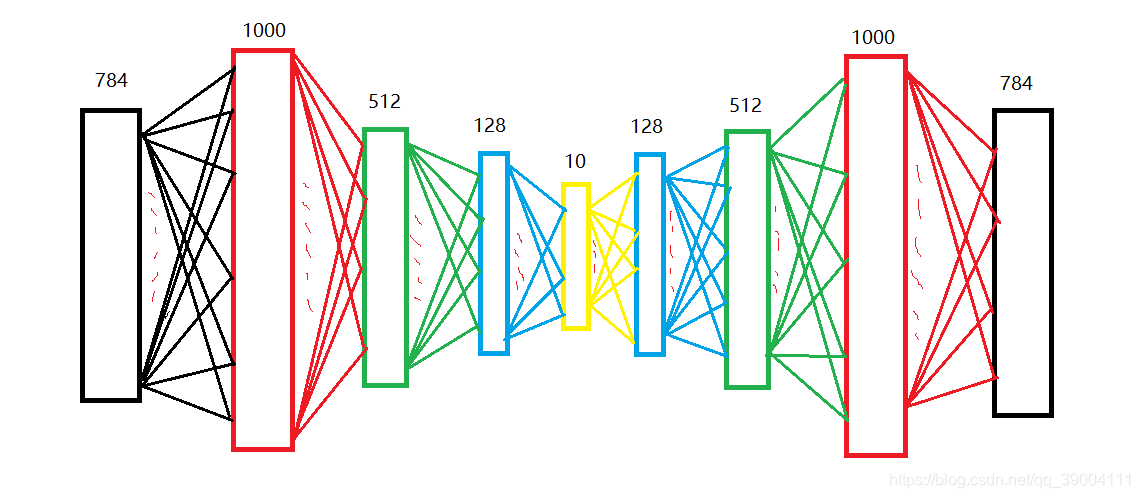因为最近在研究对抗自编码器,所以想对编码器有个大致的了解,于是就从最基础的自编码器开始看起,正好熟悉一下keras模型的搭建以及其各种各样的函数和层的调用,最后还会介绍一下如何用tensorboard将训练过程中的一些误差和精度可视化。
简单介绍一下自编码器,按照我的理解(理解可能会不是很到位,大家有问题可以留言),我们所说的自编码器通常包含了编码(encoder)和解码(decoder)两部分。编码部分呢就是相当于数据压缩,将输入的高维数据(这里所谓的高维指的是数据的属性变量较多,不是高维张量的意思)通过一定的函数使得其转化为低维的潜在特征数据(我觉着这些潜在特征没有具体的物理含义),只不过这些潜在特征能够包含原始数据中的大部分主要特征,对于一些微小的特征可能就丢失了。所以说经过编码器压缩后的特征用处很大,可以将它用于数据传输(会比传送大量原始数据快得多),也可以用这些潜在的特征构建原始数据的特征空间,对一些工业场景做过程监测或是故障诊断。当然自编码器的发明初衷就是为了加速数据传输,但是在接收端接受到了潜在的特征,如何将其还原呢?答案就是解码器,通过解码器将数据尽可能少失真的还原,所以这一方面来看解码器和编码器是个对偶的过程。关于自编码器就先简单的介绍到这里,下面我们来说一说深度自编码器的结构。
其实我觉得深度自编码器本质还是多层感知机(MLP)只不过隐层数目稍微多一点。下面就是我搭建的深度自编码器的结构。

因为是mnist数据集,都是28*28的灰度图,但是我们想将其看作数据进行操作而不是图像,所以首先将其reshape成一维张量(784,)
x_train = x_train.reshape(-1,784)#60000*784
x_test = x_test.reshape(-1,784)
紧接着再送入神经网络之前要进行一下数据的标准化,我们将0-255间的灰度像素除以255化为0-1之间,这样在训练时可以加速梯度的收敛。
#将灰度图进行归一化0-1,加速收敛
x_train = x_train.astype('float32') / 255.
x_test = x_test.astype('float32') / 255.
接下来我们可以给数据手动加上高斯噪声
x_train_noisy = x_train + noise_factor * np.random.normal(loc=0.0, scale=1.0, size=x_train.shape)
x_test_noisy = x_test + noise_factor * np.random.normal(loc=0.0, scale=1.0, size=x_test.shape)
x_train_noisy = np.clip(x_train_noisy, 0., 1.)#输出限幅
x_test_noisy = np.clip(x_test_noisy, 0., 1.)
至此数据就准备好了,下面开始搭建网络模型
# 使用一个全连接网络来搭建编码器
encoded1 = Dense(encoding_dim1, activation='relu',input_dim=784,name='Input')
encoded2 = Dense(encoding_dim2, activation='relu',name='encoder_feature1')
encoded3 = Dense(encoding_dim3, activation='relu',name='encoder_feature2')
encoded4 = Dense(encoding_dim4, activation='relu',name='encoder_feature3')
# 使用一个全连接网络来对编码器进行解码
decoded1 = Dense(encoding_dim3, activation='relu',name='decoder_feature1')
decoded2 = Dense(encoding_dim2, activation='relu',name='decoder_feature2')
decoded3 = Dense(encoding_dim1, activation='relu',name='decoder_feature3')
decoded4 = Dense(784, activation='sigmoid',name='Output')
# 构建keras模型
AutoEncoder = Sequential()
AutoEncoder.add(encoded1)
AutoEncoder.add(encoded2)
AutoEncoder.add(encoded3)
AutoEncoder.add(encoded4)
AutoEncoder.add(decoded1)
AutoEncoder.add(decoded2)
AutoEncoder.add(decoded3)
AutoEncoder.add(decoded4)
网络搭好了之后,我们来看一下模型的结构
AutoEncoder.summary()#画出模型的结构图

接下来就可以编译模型,训练了。
下图是原图和经过自编码器重构图的对比

可以看出深度自编码器的去噪效果还是挺好的。
接下来我们用tensorboard来查看训练日志。要在训练里加上一句话。
AutoEncoder.fit(x_train_noisy,x_train,epochs=10,batch_size=50,shuffle=True,verbose=1,callbacks=[TensorBoard(log_dir='my_log_dir')])
tensorflow作为后端就会生成一个叫my_log_dir的文件夹来保存训练日志,接着打开windows命令行先输入activate tensorflow1.12.0激活tensorflow虚拟环境,然后输入tensorboard --logdir=E:\MY_Python\AutoEncoder,注意这里的AutoEncoder文件夹是比my_log_dir文件夹大一级的,然后就会出现一个网页连接http://localhost:6006/,将其复制到Microsoft Edge浏览器或者是谷歌浏览器打开即可出现tensorboard界面(注意其他浏览器可能打不开)。

第一个图是训练集的loss,第二个图是验证集的loss,从第二个图可以看出来训练集的loss一直在减小,但验证集的loss反而在增加了,由此可见是过拟合了。可以加入一些正则化或者是dropout等方法处理。深度自编码器比较基础,还有一些效果出多的比如卷积自编码器、稀疏自编码器等,好了,今天就写到这了,过两天写变分自编码器。
下面是全部代码
https://github.com/JianfengZhang112358/AutoEncoder





















 5466
5466











 被折叠的 条评论
为什么被折叠?
被折叠的 条评论
为什么被折叠?








